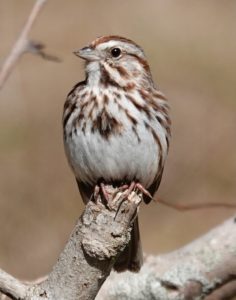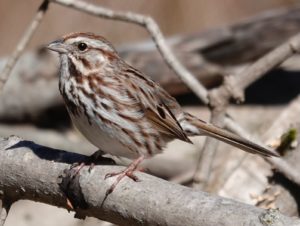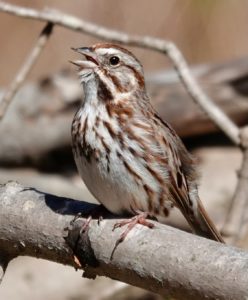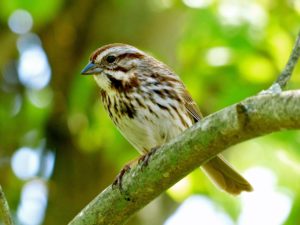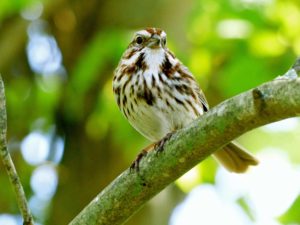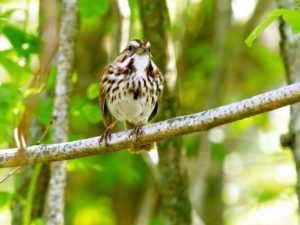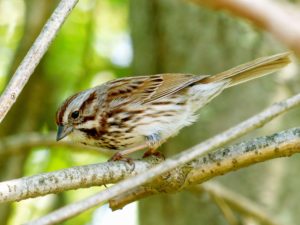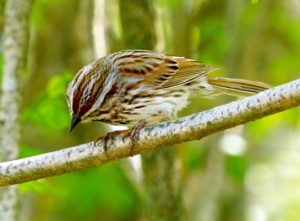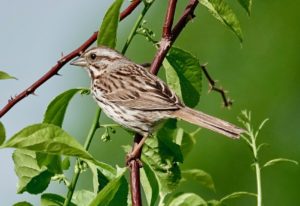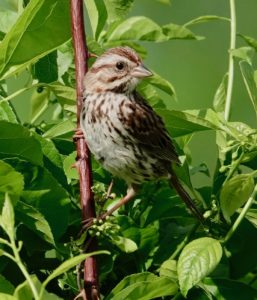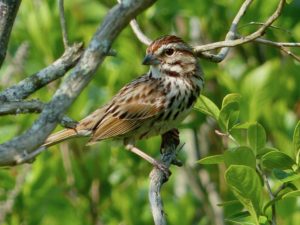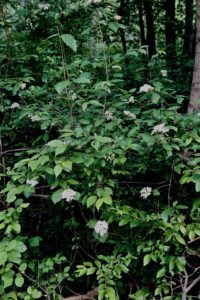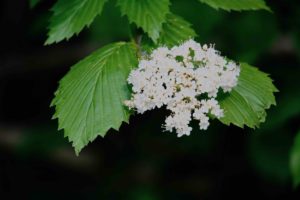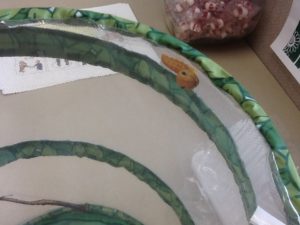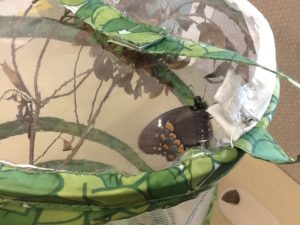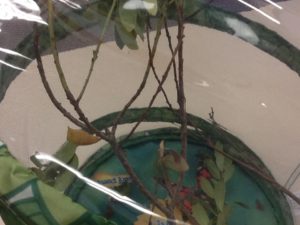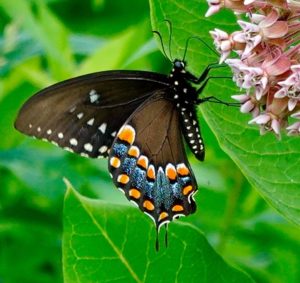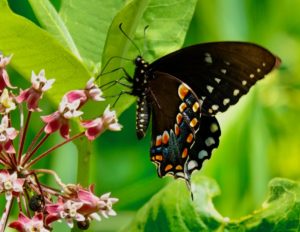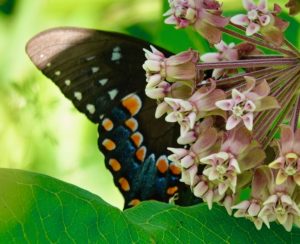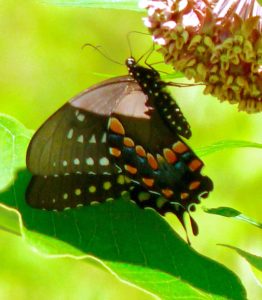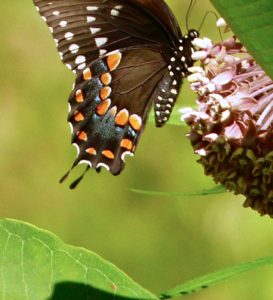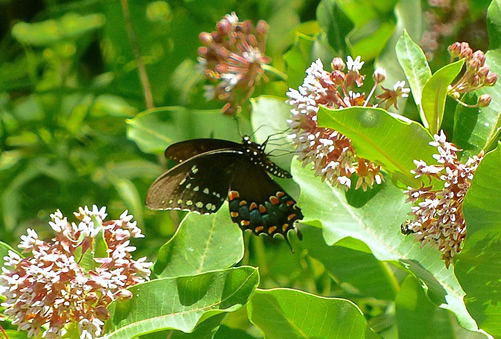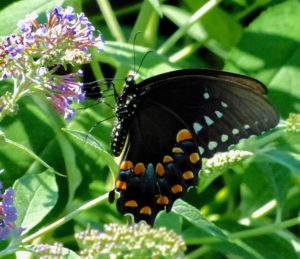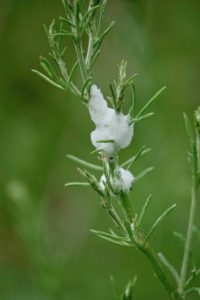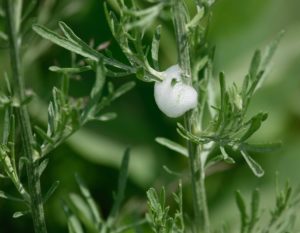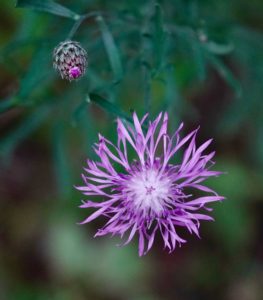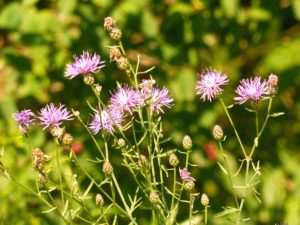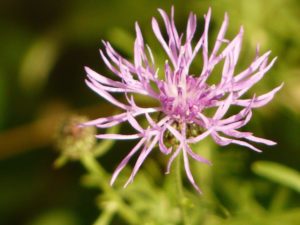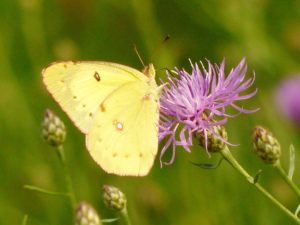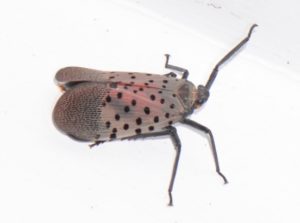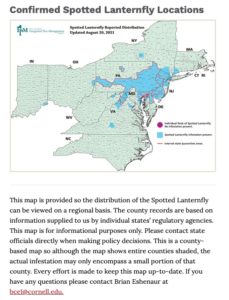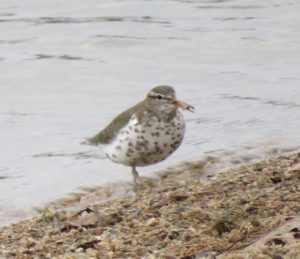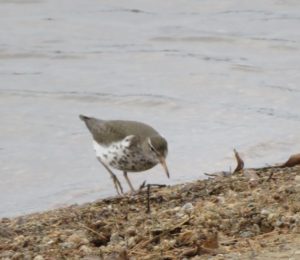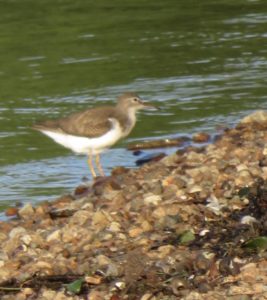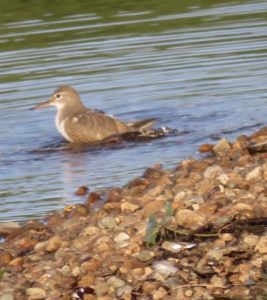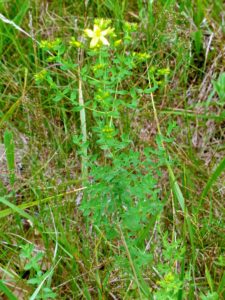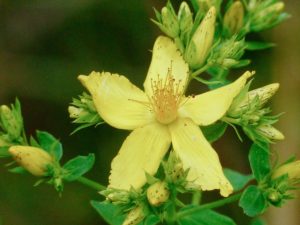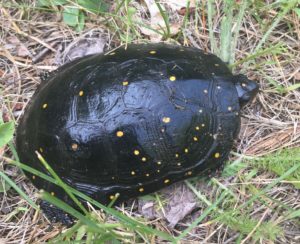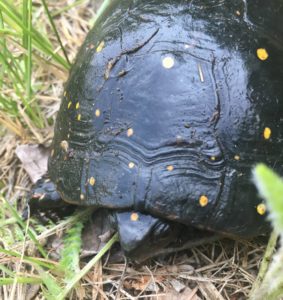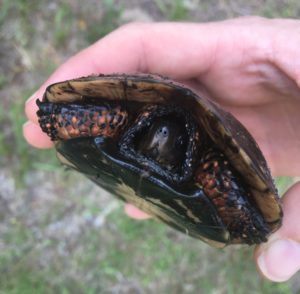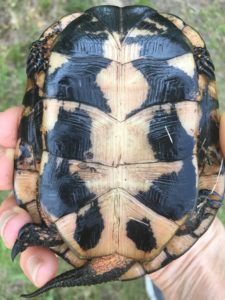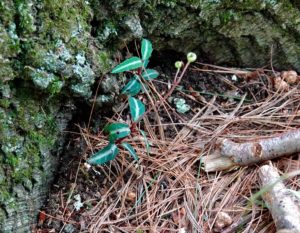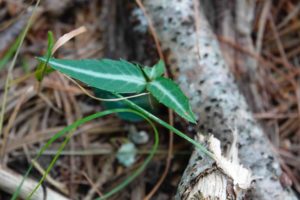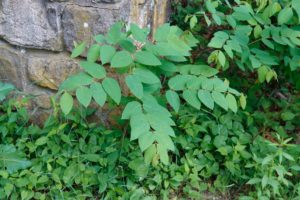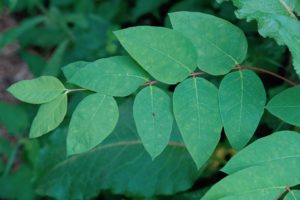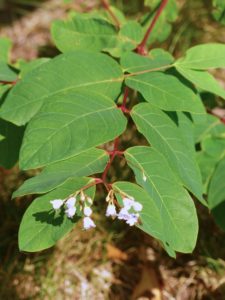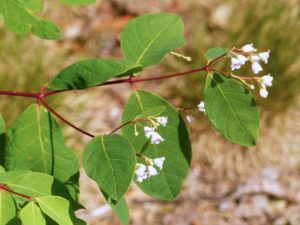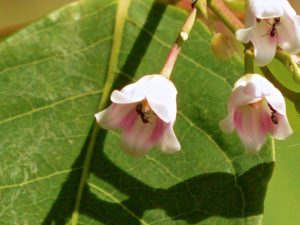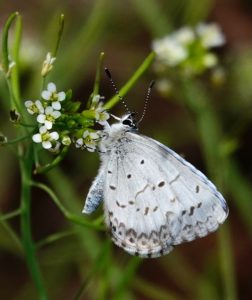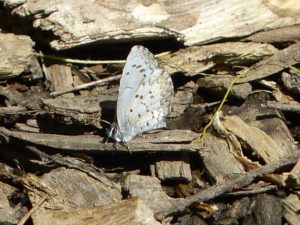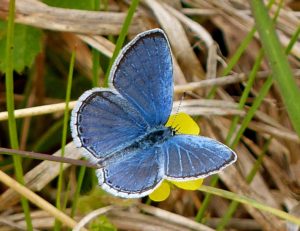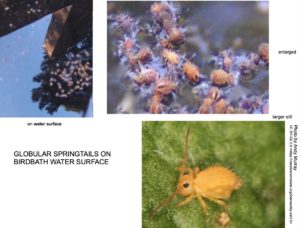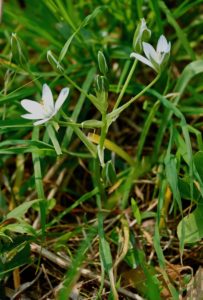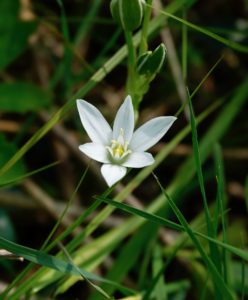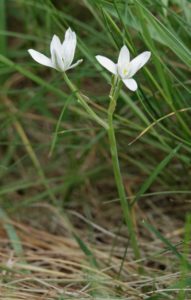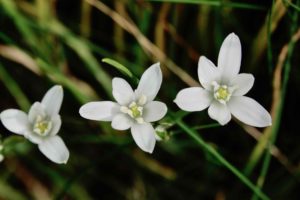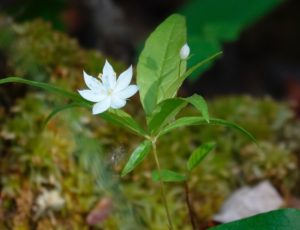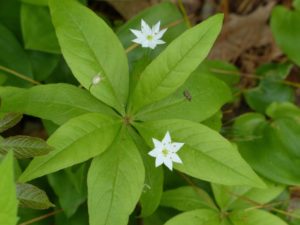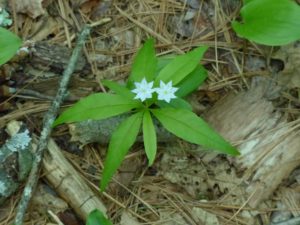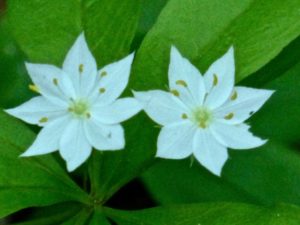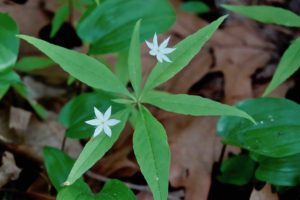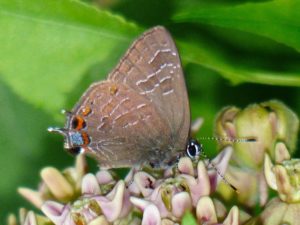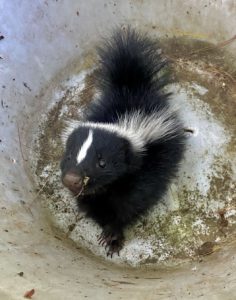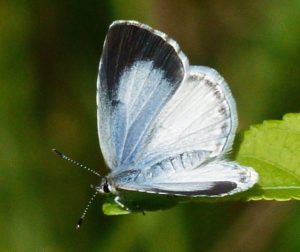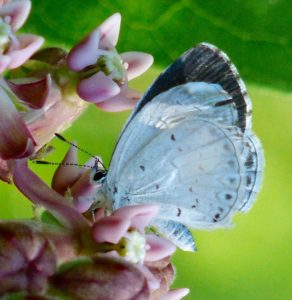Sightings grid
Observer: Paul Lauenstein
Observation Date: 4/23/24
Observation Time: 9:45 a.m.
Observation Location: Moose Hill Audubon Wildlife Sanctuary
Common Name: Song Sparrow
Scientific Name: Melospiza melodia
Comments: Song sparrows have a distinctive dark spot on their breast. This individual seems to have injured one of its left toes.
There are at least 18 species of sparrows in Massachusetts. Learning their respective calls is a good way to find and identify them. Or simply use a free cell phone app called Merlin.
More Information: All About Birds
Observer: Paul Lauenstein
Observation Date: 4/7/11
Observation Time: 5:40 p.m.
Observation Location: Gavins Pond Road near soccer fields
Common Name: Song Sparrow
Scientific Name: Melospiza melodia
Comments: This song sparrow was gleaning seeds. Their distinctive, melodious song is a good one to memorize because it is so common.
More Information: Cornell Lab of Ornithology “All About Birds”
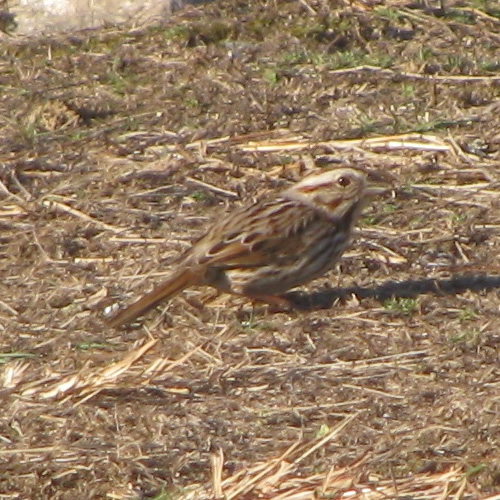
Observer: Paul Lauenstein
Observation Date: 5/29/16
Observation Time: 1:50 p.m.
Observation Location: near Lake Massapoag boat ramp
Common Name: Song Sparrow
Scientific Name: Melospiza melodia
Comments: There are at least 18 species of sparrows in Massachusetts. Learning their respective calls is a good way to find and identify them. The spot on its chest also helps with identification.
More Information: All About Birds
Observer: Paul Lauenstein
Observation Date: 5/29/14
Observation Time: 11:25 a.m.
Observation Location: Borderland State Park
Common Name: Song Sparrow
Scientific Name: Melospiza melodia
Comments: There are at least 18 species of sparrows in Massachusetts. Learning their respective calls is a good way to find and identify them.
More Information: All About Birds
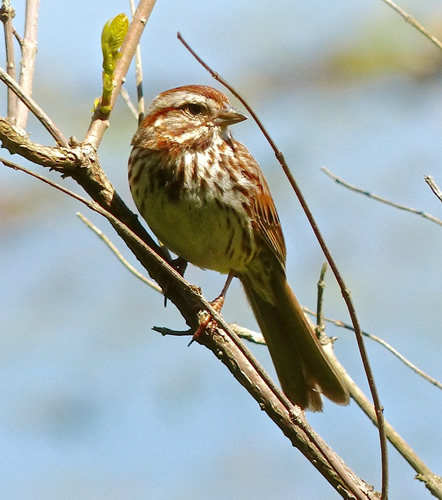
Observer: Paul Lauenstein
Observation Date: 5/31/20
Observation Time: 4:50 p.m.
Observation Location: Trustees of Reservations’ Moose Hill Farm
Common Name: Song Sparrow
Scientific Name: Melospiza melodia
Comments: There are at least 18 species of sparrows in Massachusetts. Learning their respective calls is a good way to find and identify them.
More Information: All About Birds
Observer: Paul Lauenstein
Observation Date: 6/2/19
Observation Time: 3:45 p.m.
Observation Location: in the wetlands beneath the power lines across the street from Ward’s Berry Farm
Common Name: Song Sparrow
Scientific Name: Melospiza melodia
Comments: There are at least 18 species of sparrows in Massachusetts. Learning their respective calls is a good way to find and identify them.
More Information: All About Birds
Observer: Paul Lauenstein
Observation Date: 6/13/20
Observation Time: 5:00 p.m.
Observation Location: Moose Hill Audubon Wildlife Sanctuary
Common Name: Southern Arrowwood
Scientific Name: Viburnum dentatum
Comments: Native Americans reportedly used the straight stems of this species for arrow shafts, hence the common name. The scientific name “dentatum” refers to the toothed edges of its leaves.
More Information: Missouri Botanical Garden
Observer: Paul Lauenstein
Observation Date: 5/19/12
Observation Time: 5:40 p.m.
Observation Location: dirt road leading to Gavins Pond Dam
Common Name: Spangled skimmer dragonfly (female)
Scientific Name: Libellula cyanea
Comments: This photo is a female. Male spangled skimmers are slate blue. Hence the species name “cyanea” which refers to its cyan (blue) coloration.
Identifying dragonflies and damselflies is fun. Get a copy of A Field Guide to the Dragonflies and Damselflies of Massachusetts by Blair Nikula, Jennifer L. Loose, and Matthew R. Burne.
More Information: Dragonflies and Damselflies of NJ
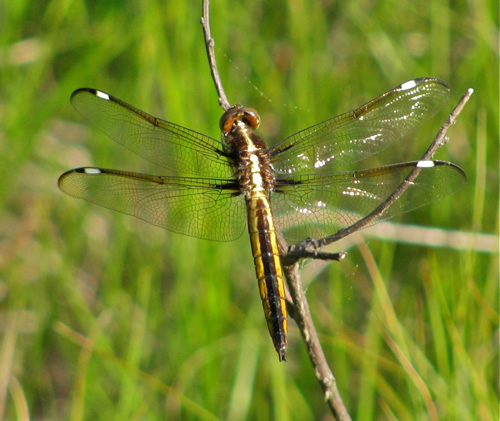
Observer: Paul Lauenstein
Observation Date: 6/17/13
Observation Time: 4:00 p.m.
Observation Location: Gavins Pond Dam
Common Name: Spangled Skimmer dragonfly (male)
Scientific Name: Libellula cyanea
Comments: Males of this species are blue, while females are brown. Both have striking white and black stigmas on their wings. No other dragonfly in the Northeast has white stigmas on its wings. Males are territorial.
More Information: Dragonflies and Damselflies of NJ
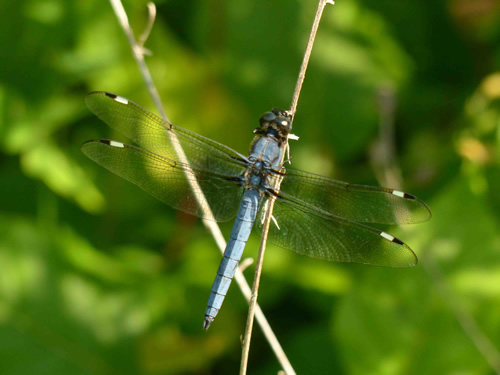
Observer: Sherry Berlingo
Observation Dates:
Spicebush Swallowtail Caterpillar – Found on playground in Sharon 09/20/16
Spicebush Swallowtail Chrysalis – Formed chrysalis on 09/22/16
Overwintered in outdoor shed
Spicebush Swallowtail Butterfly – Emerged on 06/01/17, released on 06/02/17
Observation Location: The Childrens Center, Sharon Public School
Common Name: Spicebush Swallowtail butterfly
Scientific Name: Papilio troilus
Comments: This large black butterfly is more common in Sharon than the similar black swallowtail. Learn how to tell them apart at: http://www.naba.org/chapters/nabambc/frames-2species.asp?sp1=Papilio-polyxenes&sp2=Papilio-troilus
More Information: Wikipedia
Observer: Paul Lauenstein
Observation Date: 6/24/21
Observation Time: 12:55 p.m.
Observation Location: Moose Hill Audubon (Billings Loop near the barn)
Common Name: Spicebush Swallowtail butterfly
Scientific Name: Papilio troilus
Comments: This spicebush swallowtail butterfly was observed feeding on milkweed flowers. Note that spicebush swallowtail butterflies are quite similar to black swallowtail butterflies. Spicebush swallowtails have a marking that looks like a comet among the row of large orange spots on each of its rear wings (see photos). The black swallowtail just has another orange spot where the spicebush has the comet marking.
More Information: Massachusetts Butterfly Club
Observer: Paul Lauenstein
Observation Date: 7/3/15
Observation Time: 3:20 p.m.
Observation Location: Town-owned land at Morse and Lakeview Sts.
Common Name: Spicebush Swallowtail butterfly
Scientific Name: Papilio troilus
Comments: This spicebush swallowtail butterfly was observed feeding on milkweed flowers. Note that spicebush swallowtail butterflies are quite similar to black swallowtail butterflies. Spicebush swallowtails have a marking that looks like a comet among the row of large orange spots on each of its rear wings (see photos). The black swallowtail just has another orange spot where the spicebush has the comet marking.
More Information: Massachusetts Butterfly Club
Observer: Paul Lauenstein
Observation Date: 7/6/14
Observation Time: 1:45 p.m.
Observation Location: Gavins Pond area near soccer parking area
Common Name: Spicebush Swallowtail butterfly
Scientific Name: Papilio troilus
Comments: This spicebush swallowtail butterfly was observed feeding on milkweed flowers. Note that spicebush swallowtail butterflies are very similar to black swallowtail butterflies. Learn how to tell the difference at: http://www.naba.org/chapters/nabambc/frames-2species.asp?sp1=Papilio-polyxenes&sp2=Papilio-troilus
Observer: Paul Lauenstein
Observation Date: 8/4/17
Observation Time: 1:45 p.m.
Observation Location: 4 Gavins Pond Rd. (back yard)
Common Name: Spicebush Swallowtail butterfly
Scientific Name: Papilio troilus
Comments: The butterfly bush I planted in our back yard attracts beautiful butterflies like this one. Note the blue “comet” marking on its hind wing, which differentiates spicebush swallowtails from black swallowtails.
More Information: Butterflies and Moths of North America
Observer: Paul Lauenstein
Observation Date: 7/4/13
Observation Time: 8:45 a.m.
Observation Location: Gavins Pond Dam
Common Name: Spined Soldier Bug (nymph)
Scientific Name: Podisus maculiventris
Comments: Spined soldier bugs are small predatory stink bugs. They molt several times before reaching maturity. Each phase is referred to as an instar. This one was in the third “instar”.
More Information: University of Florida
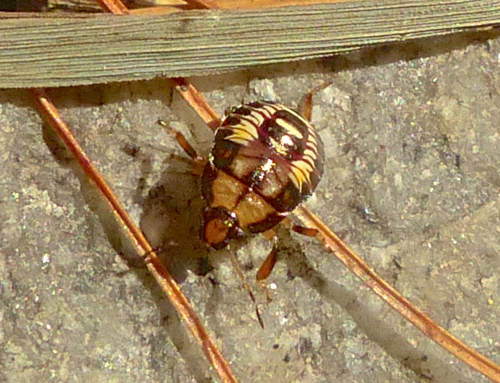
Observer: Paul Lauenstein
Observation Date: 6/9/20
Observation Time: 1:50 p.m.
Observation Location: beside soccer parking area on Gavins Pond Rd
Common Name: Spittlebug
Scientific Name: Philaenus spumarius
Comments: Spittlebugs are known for the frothy spittle mass they produce while feeding on plants.
More Information: University of Minnesota Extension
Observer: Paul Lauenstein
Observation Date: 6/27/10
Observation Time: 8:15 p.m.
Observation Location: Gavins Pond Road-soccer parking area
Common Name: Spotted knapweed
Scientific Name: Centaurea maculosa
Comments: Knapweed is a pioneer species found in recently disturbed sites or openings. Once it has been established at a disturbed site, it continues to spread into the surrounding habitat. This species outcompetes natives through at least three methods:
- A tap root that sucks up water faster than the root systems of its neighbors,
- Quick spread through high seed production, and
- Low palatability, meaning it is less likely to be chosen as food by herbivores. It is also suspected to be allelopathic, releasing a toxin from its roots that stunts the growth of nearby plants of other species.
More Information: Wikipedia
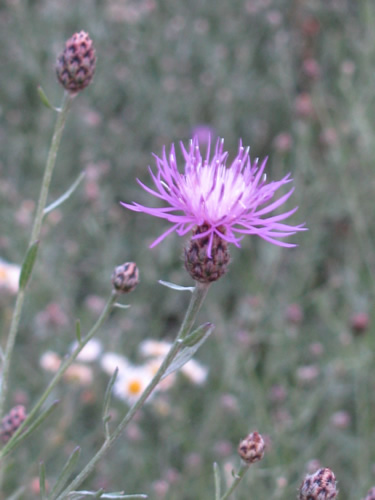
Observer: Paul Lauenstein
Observation Date: 7/12/20
Observation Time: 7:00 p.m.
Observation Location: along Gavins Pond Road
Common Name: Spotted Knapweed
Scientific Name: Centaurea maculosa
Comments: Spotted knapweed is not native to North America (it came from Europe). It is poisonous to other plants, creating barren areas where only knapweed grows. It can be a skin irritant.
More Information: namethatplant.net
Observer: Paul Lauenstein
Observation Date: 7/22/15
Observation Time: 4:40 p.m.
Observation Location: Gavins Pond area
Common Name: Spotted Knapweed
Scientific Name: Centaurea maculosa
Comments: Spotted knapweed is poisonous to other plants, creating barren areas where only knapweed grows. It is a threat to pastures and dry ecosystems including prairies and dunes. Can be a skin irritant.
More Information: Michigan Invasive Species
Observer: John Baur
Observation Date: 8/7/21
Observation Time: 10:09 p.m.
Observation Location: Old Wolomolopoag Street
Common Name: Spotted Lanternfly
Scientific Name: Lycorma delicatula
Comments: I photographed a Spotted Lanternfly at my garage. I submitted it to iNaturalist. You can see the photo here:https://www.inaturalist.org/observations/90398980. I also reported this invasive pest species to the state.
The Spotted Lanternflyis native to China and was first detected in Pennsylvania in September 2014 (see attached map). If allowed to spread in the United States, this pest could seriously impact the country’s grape, orchard, and logging industries.
More Information: Mass.gov and Massachusetts Introduced Pests Outreach Program and Cornell CALS and National Invasive Species Information Center and Wikipedia
Observer: Deb Radovsky
Observation Date: 5/12/18
Observation Time: 7:30 a.m.
Observation Location: Lake Massapoag
Common Name: Spotted Sandpiper
Scientific Name: Actitis macularius
Comments: The Spotted Sandpiper is the most widespread breeding sandpiper in North America. Female Spotted Sandpipers sometimes practice an unusual breeding strategy called polyandry, where a female mates with up to four males, each of which then cares for a clutch of eggs.
More Information: All About Birds
Observer: Paul Lauenstein
Observation Date: 7/31/10
Observation Time: 11:15 a.m.
Observation Location: Gavins Pond outflow pool
Common Name: Spotted Sandpiper
Scientific Name: Actitis macularia
Comments: Though you may think of the beach as the best place to see a sandpiper, look for Spotted Sandpipers alone or in pairs along the shores of lakes, rivers, and streams.
More Information: All About Birds
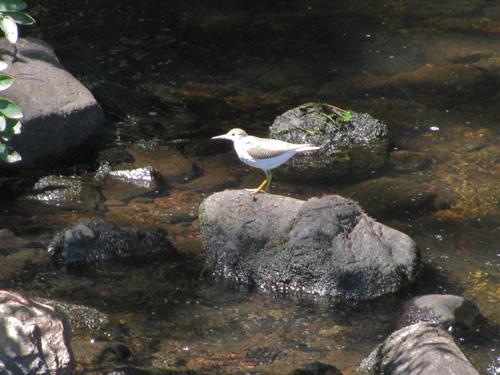
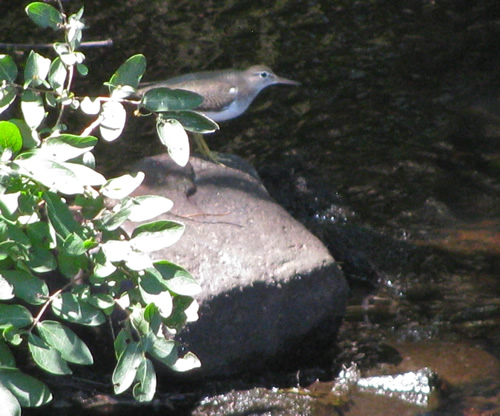
Observer: Deborah Radovsky
Observation Date: 8/6/20
Observation Time: 7:00 a.m.
Observation Location: Lake Massapoag
Common Name: Spotted Sandpiper
Scientific Name: Actitis macularius
Comments: The Spotted Sandpiper is the most widespread breeding sandpiper in North America. Female Spotted Sandpipers sometimes practice an unusual breeding strategy called polyandry, where a female mates with up to four males, each of which then cares for a clutch of eggs.
More Information: All About Birds
Observer: Paul Lauenstein
Observation Date: 6/25/15
Observation Time: 2:25 p.m.
Observation Location: Town-owned conservation land at Morse and Lakeview Streets
Common Name: Spotted St. John’s Wort
Scientific Name: Hypericum punctatum
Comments: Spotted St. John’s-wort can be most easily distinguished from the other St. John’s-worts by the dark dots and streaks on the upper surface of the yellow petals. In the other species these markings are absent or confined to near the petal margins.
Observer: Paul Lauenstein
Observation Date: 6/28/10
Observation Time: 8:00 a.m.
Observation Location: Gavins Pond Road behind Shaw’s Plaza
Common Name: Spotted Turtle (female)
Scientific Name: Clemmys guttata
Comments: This female spotted turtle may have been searching for a sandy spot to lay eggs. It may take up to 7 years for a spotted turtle to reach sexual maturity. Or perhaps it was returning to deeper water after the vernal pool dried up where it was feeding on amphibian eggs. Young spotted turtles only have one yellow spot per scute. More yellow spots appear as they age.
Many turtles get run over by cars. If you find a turtle on a road, dead or alive, please report it to the Massachusetts Turtle Atlas
More Information: Mass. Natural Heritage and Endangered Species Program (NHESP) “Massachusetts Forestry Conservation Management Practices for Spotted Turtles”
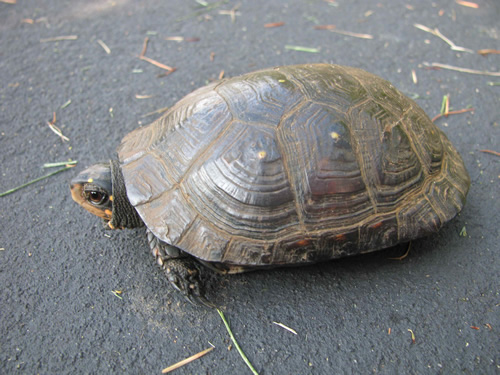
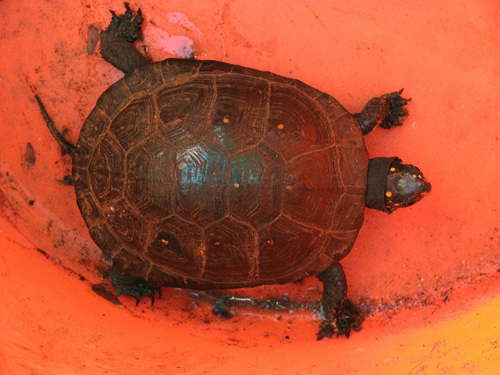
Observer: Zahava Friedman
Observation Date: 7/17/18
Observation Time:
Observation Location: Gavins Pond Road
Common Name: Spotted Turtle
Scientific Name: Clemmys guttata
Comments: Rare in Massachusetts. Spotted turtles visit vernal pools in spring to feed on amphibian eggs. When the pools dry up in summer, they must trek overland to return to a permanent pond. Unfortunately, this often entails crossing roads.
More Information: Natural History and Endangered Species Program of Massachusetts
Observer: Kurt Buermann
Observation Date: 7/28/17
Observation Location: King Philips Trail, Sharon
Common Name: Spotted Turtle
Scientific Name: Clemmys guttata
Comments: Rare in Massachusetts. Spotted turtles visit vernal pools in spring to feed on amphibian eggs. When the pools dry up in summer, they must trek overland to return to a permanent pond. Unfortunately, this often entails crossing roads.
More Information: Natural History and Endangered Species Program of Massachusetts
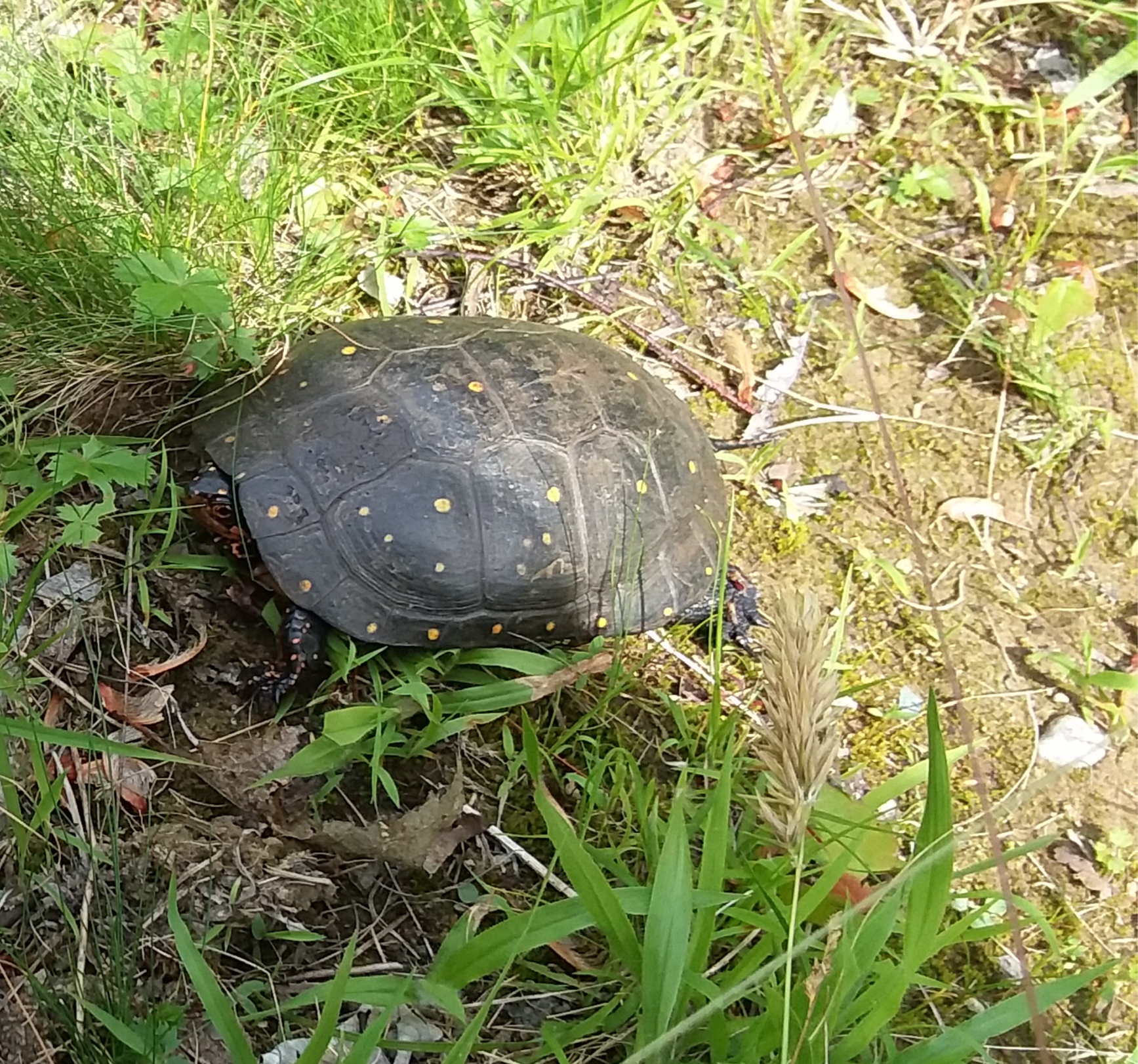
Observer: Paul Lauenstein
Observation Date: 6/4/11
Observation Time: 3:20 p.m.
Observation Location: conservation land near Billings Street
Common Name: Spotted Wintergreen
Scientific Name: Chimaphila maculata
Comments: Also called spotted wintergreen, it is endangered in Illinois and Maine. In New York it is considered “Exploitably Vulnerable.”
More Information: Wikipedia
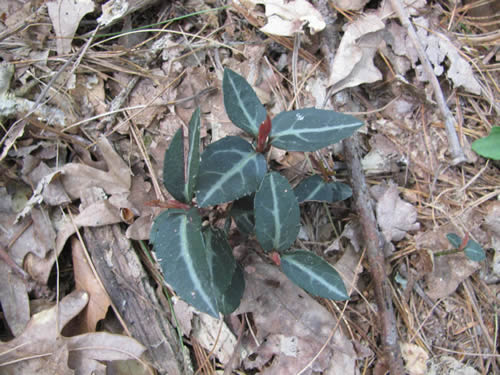
Observer: Rita Corey
Observation Date: 8/13/20
Observation Time: 1:55 p.m.
Observation Location: Mountain St.
Common Name: Spotted Wintergreen
Scientific Name: Chimaphila maculata
Comments: Spotted wintergreen is a highly recognizable understory species having variegated leaves with pale green veins. It is endangered in Maine.
More Information: Go Botany
Observer: Paul Lauenstein
Observation Date: 6/13/20
Observation Time: 6:15 p.m.
Observation Location: Moose Hill Audubon Wildlife Sanctuary
Common Name: Spreading Dogbane
Scientific Name: Apocynum androsaemifolium
Comments: Spreading dogbane is a showy member of the dogbane family (Apocynaceae) that is found in nearly all of the 50 states except some in the southeast. The common name, dogbane, and the genus name, “Apocynum,” meaning “away from dog,” are testaments to the toxic nature of this plant, not only to dogs, but to humans, livestock, and other mammals as well. The plant is poisonous due to the cardiac glycosides it contains.
Spreading dogbane is common in North America, and is widespread across most of the United States and Canada, and in Alaska, California, and northeast Mexico.
More Information: U.S. Forest Service
Observer: Paul Lauenstein
Observation Date: 7/11/15
Observation Time: 3:15 p.m.
Observation Location: near Gavins Pond
Common Name: Spreading Dogbane
Scientific Name: Apocynum androsaemifolium
Comments: Spreading dogbane is common in North America, and is widespread across most of the United States and Canada, and in Alaska, California, and northeast Mexico. The plant is poisonous, due to the cardiac glycosides it contains.
Note the ants feeding on the nectar in the blossoms in the close-up photo below.
More Information: Wikipedia
Observer: Paul Lauenstein
Observation Date: 4/25/23
Observation Time: 1:25 pm
Observation Location: Gavins Pond Rd (my back yard)
Common Name: Spring Azure butterfly
Scientific Name: Celastrina spp.
Comments: Spring azures are small butterflies that emerge in early spring. The wings are blue on top and white with dark specks on the underside. It’s hard to get a photo of the beautiful blue on the upper side of their wings because they typically close their wings, as shown in this photo, when they are not flying.
More Information: New Jersey Butterflies
Observer: Paul Lauenstein
Observation Date: 4/29/12
Observation Time: 1:30 p.m.
Observation Location: Field near Gavins Pond Dam
Common Name: Spring Azure butterfly
Scientific Name: Genus Celastrina
Comments: This is either Celastrina ladon or Celastrina lucia. Spring azures are small butterflies that emerge in early spring. The wings are blue on top and pale white with black spots on the bottom. This specimen is worn, faded and probably nearing the end.
More Information: New Jersey Butterflies
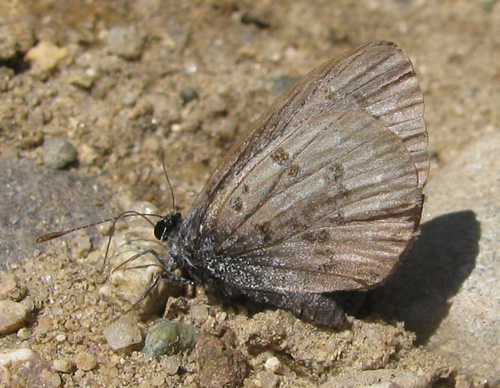
Observer: Paul Lauenstein
Observation Date: 5/11/19
Observation Time: 11:00 a.m.
Observation Location: Moose Hill Audubon Wildlife Sanctuary
Common Name: Spring Azure butterfly
Scientific Name: Celastrina spp.
Comments: Spring azures are small butterflies that emerge in early spring. The wings are blue on top and white with dark specks on the underside. It’s hard to get a photo of the beautiful blue on the upper side of their wings because they typically close their wings, as shown in this photo, when they are not flying.
More Information: New Jersey Butterflies
Observer: Paul Lauenstein
Observation Date: 5/19/13
Observation Time: 2:40 p.m.
Observation Location: Field near Gavins Pond Dam
Common Name: Spring Azure butterfly
Scientific Name: Celastrina spp.
Comments: Spring azures are small butterflies that emerge in early spring. The wings are blue on top and pale white with black spots on the bottom.
More Information: New Jersey Butterflies
Observer: Kurt Buermann
Observation Date: 11/29/20
Observation Time: 10:00 a.m.
Observation Location: 45 Furnace St.
Common Name: Globular Springtails
Scientific Name: Sminthuridae
Comments: I have often seen these brown dots floating in water, ponds or birdbaths. Today I got really curious. With the naked eye they seem like some sort of pollen. If you scoop a few onto your finger tip they jump off so they are very much alive. Each is separate but they really seem to get together in clumps. They are about 1 to 1.5 millimeters in size.
More information: Wikipedia
Observer: Paul Lauenstein
Observation Date: 7/25/10
Observation Time: 11:10 a.m.
Observation Location: Gavins Pond Road
Common Name: Staghorn Sumac
Scientific Name: Rhus typhina
Comments: Staghorn sumac grows in gardens, lawns, the edges of forests, and wasteland. It can grow under a wide array of conditions, but is most often found in dry and poor soil on which other plants cannot survive. Some landscapers remove all but the top branches to create a “crown” effect in order to resemble a small palm tree.
More Information: Wikipedia
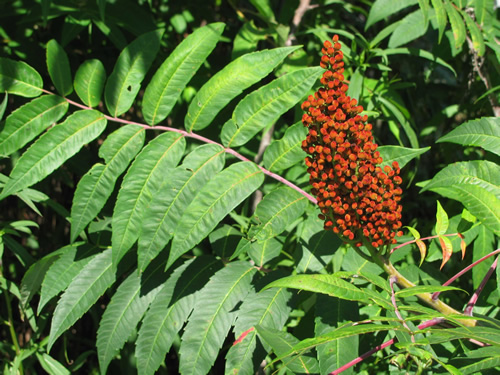
Observer: Paul Lauenstein
Observation Date: 5/11/23
Observation Time: 9:50 a.m.
Observation Location: Moose Hill Audubon Wildlife Sanctuary
Common Name: Star of Bethlehem
Scientific Name: Ornithogalum umbellatum
Comments: The Star of Bethlehem is a genus (Ornithogalum) of perennial plants native to southern Europe belonging to the family Hyacinthaceae. Growing from a bulb, it has grass-like basal leaves and a slender stalk, up to 12 inches tall, bearing clusters of star-shaped white flowers striped with green.
More Information: Illinois Wildflowers
Observer: Paul Lauenstein
Observation Date: 5/31/20
Observation Time: 5:00 p.m.
Observation Location: Trustees of Reservations’ Moose Hill Farm
Common Name: Star of Bethlehem
Scientific Name: Ornithogalum umbellatum
Comments: The Star of Bethlehem is a genus (Ornithogalum) of perennial plants native to southern Europe belonging to the family Hyacinthaceae. Growing from a bulb, it has grass-like basal leaves and a slender stalk, up to 30 cm tall, bearing clusters of star-shaped white flowers striped with green.
More Information: Illinois Wildflowers
Observer: Paul Lauenstein
Observation Date: 6/2/11
Observation Time: 1:05 p.m.
Observation Location: Gavins Pond Road near soccer field parking lot
Common Name: Star of Bethlehem
Scientific Name: Ornithogalum umbellatum
Comments: The Star of Bethlehem is a genus (Ornithogalum) of perennial plants native to southern Europe belonging to the family Hyacinthaceae. Growing from a bulb, it has grass-like basal leaves and a slender stalk, up to 30 cm tall, bearing clusters of star-shaped white flowers striped with green.
More Information: Illinois Wildflowers
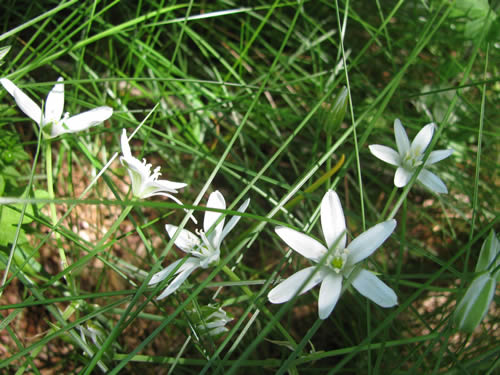
Observer: Paul Lauenstein
Observation Date: 5/13/23
Observation Time: 8:00 a.m.
Observation Location: Moose Hill Audubon Wildlife Sanctuary
Common Name: Starflower
Scientific Name: Lysimachia borealis
Comments: Formerly known as Trientalis borealis, it has been shuffled around to new species name Lysimachia borealis (same genus as the yellow Loosestrifes) and moved to the Myrsinaceae (Myrsine) family. This member of the primrose family likes moist woods. It blooms in May.
Please do not dig up native wildflowers. They typically do not survive transplantation.
More Information: Minnesota Wildflowers
Observer: Paul Lauenstein
Observation Date: 5/14/11
Observation Time: 2:05 p.m.
Observation Location: Town conservation land near Beaver Brook
Common Name: Starflower
Scientific Name: Trientalis borealis
Comments: This member of the primrose family likes moist woods. It blooms in May. Please do not dig up native wildflowers. They typically do not survive transplantation.
More Information: U.S. Dept. of Agriculture
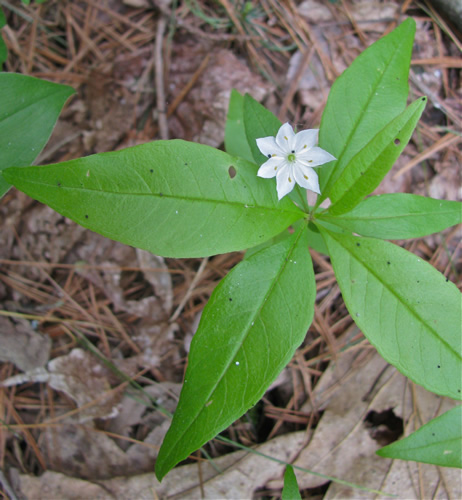
Observer: Paul Lauenstein
Observation Date: 5/19/19
Observation Time: 2:35 p.m.
Observation Location: Billings Loop Botanical Trail
Common Name: Starflower
Scientific Name: Lysimachia borealis
Comments: Formerly known as Trientalis borealis, it has been shuffled around to new species name Lysimachia borealis (same genus as the yellow Loosestrifes) and moved to the Myrsinaceae (Myrsine) family. This member of the primrose family likes moist woods. It blooms in May. Please do not dig up native wildflowers. They typically do not survive transplantation.
More Information: Minnesota Wildflowers
Observer: Paul Lauenstein
Observation Date: 5/22/18
Observation Time: 9:35 a.m.
Observation Location: Town conservation land near Beaver Brook
Common Name: Starflower
Scientific Name: Trientalis borealis
Comments: This member of the primrose family likes moist woods. It blooms in May. Please do not dig up native wildflowers. They typically do not survive transplantation.
More Information: U.S. Dept. of Agriculture
Observer: Paul Lauenstein
Observation Date: 5/27/20
Observation Time: 5:10 p.m.
Observation Location: near footbridge over Beaver Brook
Common Name: Starflower
Scientific Name: Lysimachia borealis
Comments: Formerly known as Trientalis borealis, it has been shuffled around to new species name Lysimachia borealis (same genus as the yellow Loosestrifes) and moved to the Myrsinaceae (Myrsine) family. This member of the primrose family likes moist woods. It blooms in May.
Please do not dig up native wildflowers. They typically do not survive transplantation.
More Information: Minnesota Wildflowers
Observer: Paul Lauenstein
Observation Date: 7/7/15
Observation Time: 7:45 p.m.
Observation Location: Town-owned land at Morse and Lakeview Streets
Common Name: Striped Hairstreak butterfly
Scientific Name: Satyrium liparops
Comments: This small butterfly was feeding on milkweed blossoms. Striped hairstreaks are often present in small numbers when milkweeds and dogbanes are in bloom.
Striped hairstreaks closely resemble banded hairstreaks. The blue marginal spot on the hind wing is capped with orange in the striped hairstreak but not in the banded hairstreak.
More Information: Massachusetts Butterfly Club
Observer: Michael Bissanti
Observation Date: 6/30/22
Observation Time: morning
Observation Location: Moose Hill St.
Common Name: Striped Skunk
Scientific Name: Mephitis mephitis
Comments: The little skunks in the attached video were a riot! Not shy at all, they would wander right onto our patio and didn’t seem to be bothered by our being there. I did some research and learned young skunks don’t spray, so I took a chance and scooped them into the bucket…the tails went up but no smell…my lucky day.
The skunk family is composed of four genera (Mephitis, Conepatus, Spilogale, and Mydaus) and 12 species, 10 of which are found in the Western Hemisphere. Primarily nocturnal, skunks are a diverse group of carnivores that live in a wide variety of habitats, including deserts, forests, and mountains. Skunks are also known as polecats.
More Information: Britannica.com
Observer: Deborah Radovsky
Observation Date: 5/11/17
Observation Time: early morning
Observation Location: Moose Hill, Billings Loop
Common Name: Sugar Maple Tree
Scientific Name: Acer saccharum
Comments: The two huge sugar maples near the barn on the Billings Loop are called George and Martha because they began life at around the same time as George Washington and his wife Martha. The Moose Hill Audubon Wildlife Sanctuary taps many of the sugar maples on its 2,000-acre property in late winter and makes maple syrup.
More Information: Arbor Day Foundation
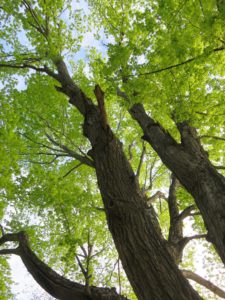
Observer: Paul Lauenstein
Observation Date: 9/22/13
Observation Time: 2:20 p.m.
Observation Location: King Phillip’s Rock area
Common Name: Sulphur Shelf Mushroom
Scientific Name: Laetiporus sulphureus
Comments: Sulphur shelf mushrooms are reportedly edible, but never eat a mushroom you find in the woods unless you are absolutely sure it is not poisonous. More pictures of sulphur shelf mushrooms can be seen at: http://hicksroad.com/html/stumpfun.htm.
More Information: Wikipedia
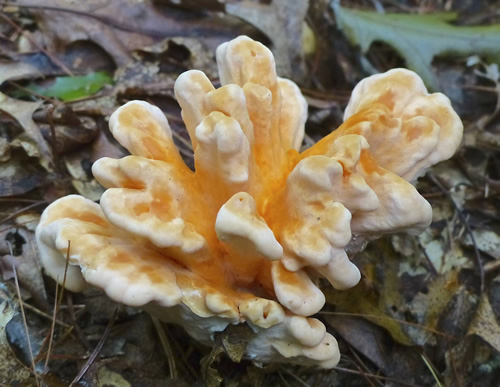
Observer: Paul Lauenstein
Observation Date: 6/27/15
Observation Time: 10:25 a.m.
Observation Location: Town land near Morse and Lakeview Streets
Common Name: Summer Azure butterfly
Scientific Name: Celastrina neglecta
Comments: Summer azures are small, pale blue butterflies that emerge in June.
More Information: Wikipedia

